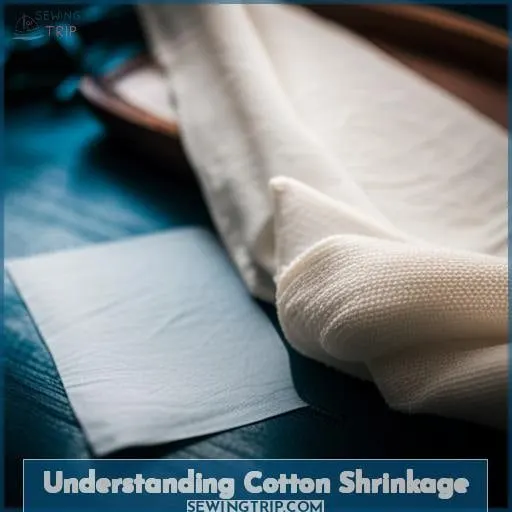This site is supported by our readers. We may earn a commission, at no cost to you, if you purchase through links.
 Like a delicate flower wilting in the sun, muslin too shrinks when washed.
Like a delicate flower wilting in the sun, muslin too shrinks when washed.
Why does this happen?
What can you do to avert this shrinkage?
This article will delve into the world of muslin, exploring its shrinkage properties and providing you with tips and tricks to tame this natural tendency.
From understanding the factors that influence shrinkage to learning techniques for minimizing it, this comprehensive guide will equip you with the knowledge to care for your muslin garments and keep them looking their best.
Table Of Contents
- Key Takeaways
- Muslin Shrinkage
- How Much Does Muslin Shrink?
- Will Muslin Shrink in the Dryer?
- Do Muslin Blankets Shrink?
- Do Muslin Quilts Shrink?
- How to Shrink Muslin
- Does Muslin Fabric Stretch?
- Understanding Cotton Shrinkage
- Flame Retardant Muslin is an Exception to the Norm
- Tips for Shopping for Muslin
- Frequently Asked Questions (FAQs)
- Conclusion
Key Takeaways
- Muslin tends to shrink when washed due to fiber relaxation, but varies by type, water temperature, and drying method.
- Pre-washing muslin removes sizing/finishes and reduces shrinkage, making it essential before sewing.
- Muslin items can shrink significantly in the dryer due to high heat, so use the lowest setting and remove items while slightly damp.
- Pre-shrinking muslin stabilizes fibers and reduces shrinkage during construction, ensuring the desired size and shape.
Muslin Shrinkage
Muslin tends to shrink when washed, which can be problematic for projects requiring precise measurements, such as quilts.
The amount of shrinkage depends on the type of muslin, water temperature, and drying method.
To minimize shrinkage, pre-wash the muslin to remove sizing or finishes.
Wash the muslin in cold water on a gentle cycle, avoiding bleach or fabric softeners.
Dry the muslin on a low heat setting or air dry it. Stretching the muslin while damp can also help prevent shrinkage.
If shrinkage is a concern, consider using a different fabric, such as cotton broadcloth or quilting cotton, which are less prone to shrinkage.
How Much Does Muslin Shrink?
Depending on the type of muslin and how it’s washed, you can expect muslin to shrink anywhere from 2% to 10%.
Muslin’s shrinkage is caused by the relaxation of cotton fibers when exposed to heat and moisture.
Pre-washing muslin can help reduce shrinkage, but it’s still important to follow the care instructions on the fabric label.
Type of Muslin:
Different types of muslin have varying degrees of shrinkage.
For instance, lightweight muslin tends to shrink more than heavier muslin.
Washing Conditions:
The temperature of the water and the agitation of the washing machine can affect the amount of shrinkage.
Hot water and vigorous agitation can cause more shrinkage than cold water and gentle agitation.
Drying Method:
Tumble drying muslin on high heat can cause significant shrinkage.
Air drying or drying on a low heat setting is recommended to minimize shrinkage.
To prevent excessive shrinkage, consider pre-washing muslin before sewing.
This helps remove any sizing or finishes that may contribute to shrinkage.
Additionally, wash and dry muslin according to the care instructions on the fabric label.
By following these tips, you can minimize shrinkage and ensure that your muslin projects turn out as expected.
Will Muslin Shrink in the Dryer?
Indeed, muslin will usually shrink in the dryer, so avoid machine drying it if you don’t want it to shrink. The high heat of the dryer can cause the fibers in muslin to contract, resulting in a noticeable reduction in size.
If you do choose to machine dry muslin, use the lowest heat setting and remove the items from the dryer while they’re still slightly damp.
To illustrate the potential shrinkage of muslin in the dryer, consider the following table:
| Item | Original Size | Size After Drying |
|---|---|---|
| Muslin Sheets | 90 x 108 | 85 x 100 |
| Muslin Curtains | 54 x 84 | 50 x 80 |
| Muslin Doll Clothes | 6 x 8 | 5.5 x 7.5 |
| Muslin Wrap | 42 x 42 | 39 x 39 |
| Muslin Cloth Diapers | 27 x 27 | 25 x 25 |
As you can see, muslin can shrink significantly in the dryer, so it’s important to take precautions to avoid this if you want to maintain the original size of your muslin items.
Do Muslin Blankets Shrink?
Muslin blankets can indeed shrink if not washed and dried properly. Follow specific care instructions to maintain their size and shape.
Muslin is a natural fiber that tends to shrink when exposed to high temperatures. To prevent excessive shrinkage, wash your muslin blanket in cold water on a gentle cycle.
To dry your muslin blanket, tumble dry it on low heat or hang it to air dry. Avoid exposing the blanket to direct sunlight, as this can also cause shrinkage.
If you’re concerned about shrinkage, you can pre-shrink the blanket before using it. To do this, wash and dry the blanket according to the care instructions. This will help to minimize shrinkage when you wash and dry the blanket in the future.
By following these care instructions, you can help to keep your muslin blanket soft, breathable, and durable for years to come.
Muslin’s breathability makes it ideal for use as a blanket, as it allows air to circulate and helps to regulate body temperature. Additionally, muslin is a durable fabric that can withstand repeated washing and drying without losing its shape or softness.
Do Muslin Quilts Shrink?
Now, let’s shift our focus to muslin quilts and their susceptibility to shrinkage.
If you’re working on a cherished quilt, particularly one intended as a gift for a loved one, the prospect of shrinkage can be unsettling.
However, with careful planning and informed techniques, you can mitigate this concern and ensure your quilt’s integrity.
- Understand the impact of washing: Muslin quilts, like other cotton-based textiles, are prone to shrinkage when exposed to high temperatures.
Washing in hot water or tumble drying on high heat can cause significant distortion, potentially affecting the quilt’s overall size and appearance.
- Embrace dense quilting and polyester batting: To combat shrinkage and maintain the quilt’s intended dimensions, consider employing dense quilting techniques.
This involves stitching the quilt top, batting, and backing together more closely, providing additional stability and reducing the fabric’s ability to contract.
Additionally, opting for polyester batting, known for its minimal shrinkage properties, can further enhance shrinkage control.
- Prioritize communication and flexibility: As you navigate the quilt-making process, keep your grandson informed of your progress and any challenges you encounter.
Maintaining open communication allows for adjustments and ensures the final product aligns with his preferences.
How to Shrink Muslin
To intentionally shrink muslin, you can apply heat through washing and drying.
Start by washing muslin in hot water.
Then, tumble dry on high heat.
Repeat the process until the desired shrinkage is achieved.
Method 1
Since muslin shrinkage is a concern, you can combat it by pre-washing and drying your muslin fabric in hot water and high heat.
This method effectively shrinks the fabric before you start working on your quilt top, minimizing fabric shrinkage and ensuring the quilt’s size and appearance remain as intended.
While this method may alter the fabric’s texture, it’s a reliable solution to prevent further shrinkage and maintain the quilt’s integrity.
Method 2
For the second method, you’ll shrink muslin by soaking it in boiling water. This technique is effective for achieving maximum shrinkage.
- Fill a large pot with water and bring it to a boil.
- Submerge the muslin fabric in the boiling water for 10-15 minutes.
- Remove the muslin from the water and allow it to cool completely.
This method is particularly useful when you want to pre-shrink muslin fabric before sewing or quilting to prevent further shrinkage and ensure the desired dimensions of your project.
Method 3
You’ll often find this third method used when the fabric has already been sewn.
Begin by soaking the sewn muslin item in hot water for 30 minutes.
Agitate it occasionally to ensure even shrinkage.
Drain the water and machine-wash the item in hot water with detergent.
Tumble dry on high heat.
This method offers shrinkage control, but it’s crucial to remember that it can also affect the overall look and feel of the muslin.
Does Muslin Fabric Stretch?
Now that you know how to shrink muslin, you might also be wondering if it stretches. Muslin’s elasticity is a crucial factor to consider, especially when working with garments or projects that require flexibility and durability.
Stretch Testing:
To assess muslin’s stretchiness, perform a simple stretch test. Hold a piece of muslin firmly at both ends and gently pull it in opposite directions. Observe the fabric’s response. If it elongates easily and returns to its original shape upon release, it possesses good stretch recovery.
Stretch Comparison:
Compare muslin’s stretchiness to other fabrics you’re familiar with. For instance, muslin generally exhibits less stretch compared to knit fabrics like jersey or spandex. However, it may stretch more than woven fabrics like canvas or denim.
Fabric Flexibility:
Muslin’s flexibility contributes to its versatility. Its ability to drape and conform to various shapes makes it suitable for garments like dresses, skirts, and blouses. Additionally, muslin’s flexibility allows for intricate folds and pleats, adding visual interest to your creations.
Understanding muslin’s elasticity helps you make informed decisions about its suitability for your projects. Whether you’re creating garments, quilts, or home décor items, considering muslin’s stretch and recovery properties ensures your projects maintain their shape and integrity over time.
Understanding Cotton Shrinkage
Cotton threads used in muslin fabric stretch during weaving. When exposed to heat, they relax and cause the fabric to shrink. Understanding this phenomenon is essential for proper fabric care and preventing unwanted shrinkage.
Cotton fibers respond to heat by relaxing and contracting, leading to shrinkage. This process is accelerated in hot water and dryer heat. Recognizing this behavior allows you to take precautions to minimize shrinkage or induce it intentionally.
To minimize shrinkage, pre-shrinking muslin is recommended. This involves washing and drying the fabric before cutting and sewing. Pre-shrinking helps stabilize the fibers and reduces the likelihood of further shrinkage during garment construction and laundering.
Hand washing in cold water is another effective method to minimize shrinkage. The gentle agitation and low water temperature prevent excessive fiber relaxation and shrinkage. Avoid wringing or twisting the fabric, as this can cause distortion and stretching.
Drying techniques also play a crucial role in controlling shrinkage. Tumble drying on high heat should be avoided, as it can cause significant shrinkage.
By understanding cotton shrinkage and implementing proper fabric care techniques, you can maintain the desired size and shape of your muslin garments and ensure their longevity.
Flame Retardant Muslin is an Exception to the Norm
Unlike cotton, flame retardant muslin, treated to resist fire, does not shrink.
This unique property stems from the chemical solution applied to the fabric, which alters its behavior when exposed to heat.
If you’re considering flame retardant muslin for stage curtains, you can order the exact size you need, accounting for hems and seams, without worrying about shrinkage.
This is particularly important for curtains used in theaters, where heat from lights can cause regular muslin to shrink and distort.
Flame retardant muslin is treated with an Inherently Flame Retardant (IFR) solution that does not wash out, ensuring lasting protection against fire.
This treatment makes the fabric inherently fire resistant, meeting strict safety standards.
So, if you’re looking for a flame-resistant fabric that won’t shrink, flame retardant muslin is the perfect choice.
Its exceptional properties make it ideal for stage curtains and other applications where fire safety is paramount.
Tips for Shopping for Muslin
When shopping for muslin, consider the following:
-
Seek Expert Guidance:
- Contact muslin wholesale suppliers or browse muslin fabric rolls online to find the right material.
- Their expertise can help you understand fabric requirements and choose the best muslin for your project.
-
Consider Flame Retardant Muslin:
- If you’re purchasing muslin for stage curtains or other applications near heat sources, opt for flame retardant muslin for added safety.
-
Choose Natural Cotton Muslin:
- For breathability and softness, select natural cotton muslin.
- It’s a versatile choice suitable for various projects, from clothing to home décor.
-
Allow for Shrinkage:
- Remember that natural cotton muslin can shrink up to 10% when washed.
- Purchase extra fabric to accommodate shrinkage and avoid surprises during your project.
-
Shop Online or in Fabric Stores:
- Muslin fabric yards are widely available online and in fabric stores.
- Compare prices, quality, and shipping options to find the best deal for your muslin needs.
Additional Tips:
- Allow for 10% shrinkage in natural cotton muslin fabrics.
- Add extra fabric for seams and hems, typically three inches on each edge.
- Natural cotton muslin is available in 100-yard rolls or by the yard up to 39 feet wide.
- Muslin backdrops come in solid colors or Old Master Style for photography.
Frequently Asked Questions (FAQs)
Does the type of muslin fabric affect the amount of shrinkage?
Muslin shrinkage varies based on its type.
Gauze and Swiss muslin, known for their lightweight nature, tend to exhibit minimal shrinkage.
Mull and sheeting muslin, being denser, may experience more noticeable shrinkage.
Is there a difference in shrinkage between muslin made from different materials, such as cotton, silk, or polyester blends?
Does the fiber composition of muslin, such as cotton, silk, or polyester blends, impact its shrinkage behavior?
Different materials exhibit varying reactions to washing, potentially influencing the extent of shrinkage.
How can I pre-treat muslin fabric to minimize shrinkage before sewing or using it for a project?
To minimize shrinkage, you can preshrink muslin by washing and drying it before sewing or using it for your project.
This process helps eliminate excess shrinkage and ensures the fabric retains its intended dimensions.
Are there any special care instructions for washing and drying muslin to prevent excessive shrinkage?
To prevent excessive shrinkage, wash muslin in cold water on a gentle cycle and tumble dry on low heat or air dry.
Consider pre-washing the fabric before sewing to account for any potential shrinkage.
What are some creative ways to use muslin fabric scraps or leftover pieces after a project to minimize waste?
Transform leftover muslin scraps into charming patchwork projects.
Create unique quilts, decorative pillows, or tote bags, blending colors and patterns for a personalized touch.
Conclusion
While muslin’s delicate charm may fade with washing, understanding and embracing its natural shrinkage can transform it into a garment that molds to your body, offering a personalized fit.
Learn to tame it, appreciate it, and enjoy the unique character it imparts to your muslin pieces.
















